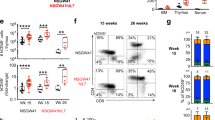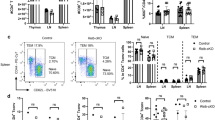Abstract
TUMOUR necrosis factor (TNF) elicits multiple biological effects through two distinct cell surface receptors, TNF-R1 (p55) and TNF-R2 (p75). Most TNF-mediated biological responses, such as cell death, gene induction, antiviral activity and cytokine production, have been attributed to TNF-R1 (refs 1–5). Gene targeting of this receptor confirms its role in the lethality attributable to low doses of lipopolysaccharide after sensitization with D-galactosamine6,7; surprisingly, the toxicity of high doses of lipopolysaccharide was unaffected. The function of TNF-R2 is less well understood, although there are data supporting a role in T-cell development and the proliferation of cytotoxic T lymphocytes8,9. To clarify the physiological role of TNF-R2, we have generated mice deficient in this receptor by gene targeting. The TNF-R2−/− mice show normal T-cell development and activity, but we find that they have increased resistance to TNF-induced death. Additionally, such mice injected subcutaneously with TNF show a dramatic decrease in tissue necrosis, indicating that this receptor plays a role in the necrotic effects of TNF.
This is a preview of subscription content, access via your institution
Access options
Subscribe to this journal
Receive 51 print issues and online access
$199.00 per year
only $3.90 per issue
Buy this article
- Purchase on Springer Link
- Instant access to full article PDF
Prices may be subject to local taxes which are calculated during checkout
Similar content being viewed by others
References
Beutler, B. & van Huffel, C. Science 264, 667–668 (1994).
Brockhaus, M. et al. Proc. natn. Acad. Sci. U.S.A. 87, 3127–3131 (1990).
Fiers, W. FEBS Lett. 285, 199–212 (1991).
Lewis, M. et al. Proc. natn. Acad. Sci. U.S.A. 88, 2830–2834 (1991).
Smith, C. A. et al. Science 248, 1019–1023 (1990).
Rothe, J. et al. Nature 364, 798–802 (1993).
Pfeffer, K. et al. Cell 73, 457–467 (1993).
Tartaglia, L. A. et al. Proc. natn. Acad. Sci. U.S.A. 88, 9292–9296 (1991).
Tartaglia, L. A. et al. J. Immun. 151, 4637–4641 (1993).
Pennica, D. et al. Biochemistry 31, 1134–1141 (1992).
Espevik, T., Brockhaus, M., Loetscher, H., Nonstad, U. & Shalaby, R. J. exp. Med. 171, 415–426 (1990).
Shalaby, M. R. et al. J. exp. Med. 172, 1517–1520 (1990).
Ashkenazi, A. et al. Proc. natn. Acad. Sci. U.S.A. 88, 10535–10539 (1991).
Tartaglia, L. A., Ayres, T. M., Wong, G. H. & Goeddel, D. V. Cell 74, 845–853 (1993).
Frankel, W. N., Rudy, C., Coffin, J. M. & Huber, B. T. Nature 349, 526–528 (1991).
Marrack, P., Kushnir, E. & Kappler, J. Nature 349, 524–526 (1991).
Crowe, P. D. et al. Science 264, 707–710 (1994).
De Togni, P. et al. Science 264, 703–707 (1994).
Tartaglia, L. A., Pennica, D. & Goeddel, D. V. J. biol. Chem. 268, 18542–18548 (1993).
McBurney, M. W. et al. Nucleic Acids Res. 19, 5755–5761 (1991).
Gossler, A., Doetschman, T., Korn, R., Serfling, E. & Kemler, R. Proc. natn. Acad. Sci. U.S.A. 83, 9065–9069 (1986).
Bradley, A. in Teratocarcinomas and Embryonic Stem Cells (ed. Robertson, E. J.) 113–152 (IRL Oxford, 1987).
Author information
Authors and Affiliations
Rights and permissions
About this article
Cite this article
Erickson, S., de Sauvage, F., Kikly, K. et al. Decreased sensitivity to tumour-necrosis factor but normal T-cell development in TNF receptor-2-deficient mice. Nature 372, 560–563 (1994). https://doi.org/10.1038/372560a0
Received:
Accepted:
Issue Date:
DOI: https://doi.org/10.1038/372560a0
This article is cited by
-
Impact of anthropogenic and environmental conditions on surface run-off quality: a case study of Nsukka, Eastern Nigeria
International Journal of Environmental Science and Technology (2023)
-
Fundamentally different roles of neuronal TNF receptors in CNS pathology: TNFR1 and IKKβ promote microglial responses and tissue injury in demyelination while TNFR2 protects against excitotoxicity in mice
Journal of Neuroinflammation (2021)
-
The many faces of tumor necrosis factor signaling in the intestinal epithelium
Genes & Immunity (2019)
-
The Role of Tumor Necrosis Factor Alpha (TNFα) in Hearing Loss and Vestibular Schwannomas
Current Otorhinolaryngology Reports (2018)
-
The microRNA miR-148a functions as a critical regulator of B cell tolerance and autoimmunity
Nature Immunology (2016)
Comments
By submitting a comment you agree to abide by our Terms and Community Guidelines. If you find something abusive or that does not comply with our terms or guidelines please flag it as inappropriate.



